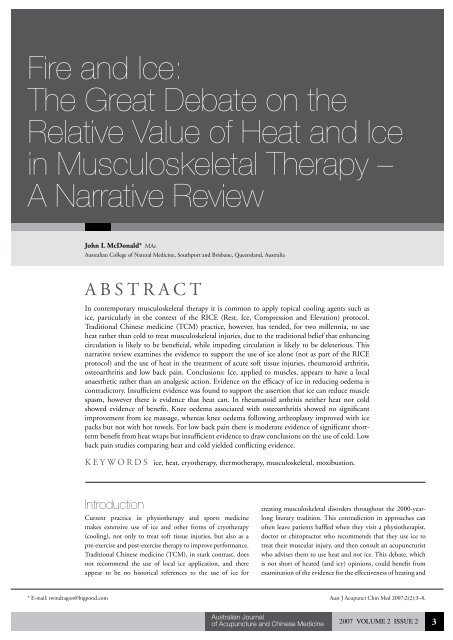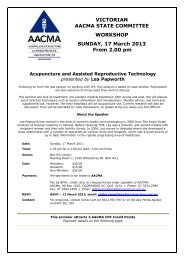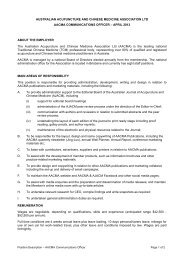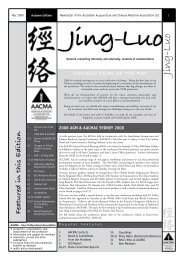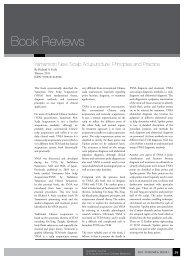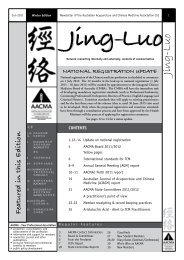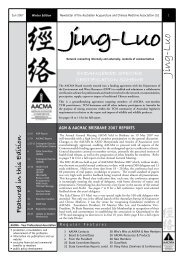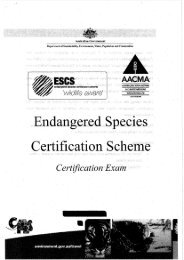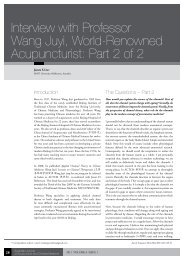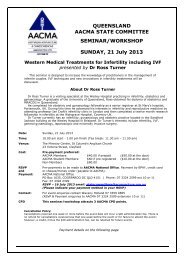Fire and Ice - Australian Acupuncture & Chinese Medicine ...
Fire and Ice - Australian Acupuncture & Chinese Medicine ...
Fire and Ice - Australian Acupuncture & Chinese Medicine ...
- No tags were found...
You also want an ePaper? Increase the reach of your titles
YUMPU automatically turns print PDFs into web optimized ePapers that Google loves.
<strong>Fire</strong> <strong>and</strong> <strong>Ice</strong>:The Great Debate on theRelative Value of Heat <strong>and</strong> <strong>Ice</strong>in Musculoskeletal Therapy –A Narrative ReviewJohn L McDonald* MAc<strong>Australian</strong> College of Natural <strong>Medicine</strong>, Southport <strong>and</strong> Brisbane, Queensl<strong>and</strong>, AustraliaA B S T R A C TIn contemporary musculoskeletal therapy it is common to apply topical cooling agents such asice, particularly in the context of the RICE (Rest, <strong>Ice</strong>, Compression <strong>and</strong> Elevation) protocol.Traditional <strong>Chinese</strong> medicine (TCM) practice, however, has tended, for two millennia, to useheat rather than cold to treat musculoskeletal injuries, due to the traditional belief that enhancingcirculation is likely to be beneficial, while impeding circulation is likely to be deleterious. Thisnarrative review examines the evidence to support the use of ice alone (not as part of the RICEprotocol) <strong>and</strong> the use of heat in the treatment of acute soft tissue injuries, rheumatoid arthritis,osteoarthritis <strong>and</strong> low back pain. Conclusions: <strong>Ice</strong>, applied to muscles, appears to have a localanaesthetic rather than an analgesic action. Evidence on the efficacy of ice in reducing oedema iscontradictory. Insufficient evidence was found to support the assertion that ice can reduce musclespasm, however there is evidence that heat can. In rheumatoid arthritis neither heat nor coldshowed evidence of benefit. Knee oedema associated with osteoarthritis showed no significantimprovement from ice massage, whereas knee oedema following arthroplasty improved with icepacks but not with hot towels. For low back pain there is moderate evidence of significant shorttermbenefit from heat wraps but insufficient evidence to draw conclusions on the use of cold. Lowback pain studies comparing heat <strong>and</strong> cold yielded conflicting evidence.K e y W o r d s ice, heat, cryotherapy, thermotherapy, musculoskeletal, moxibustion.IntroductionCurrent practice in physiotherapy <strong>and</strong> sports medicinemakes extensive use of ice <strong>and</strong> other forms of cryotherapy(cooling), not only to treat soft tissue injuries, but also as apre-exercise <strong>and</strong> post-exercise therapy to improve performance.Traditional <strong>Chinese</strong> medicine (TCM), in stark contrast, doesnot recommend the use of local ice application, <strong>and</strong> thereappear to be no historical references to the use of ice fortreating musculoskeletal disorders throughout the 2000-yearlongliterary tradition. This contradiction in approaches canoften leave patients baffled when they visit a physiotherapist,doctor or chiropractor who recommends that they use ice totreat their muscular injury, <strong>and</strong> then consult an acupuncturistwho advises them to use heat <strong>and</strong> not ice. This debate, whichis not short of heated (<strong>and</strong> icy) opinions, could benefit fromexamination of the evidence for the effectiveness of heating <strong>and</strong>* E-mail: twindragon@bigpond.com Aust J Acupunct Chin Med 2007;2(2):3–8.<strong>Australian</strong> Journalof <strong>Acupuncture</strong> <strong>and</strong> <strong>Chinese</strong> <strong>Medicine</strong>2007 VOLUME 2 ISSUE 2
<strong>Fire</strong> <strong>and</strong> <strong>Ice</strong>JL McDonaldcooling therapies for musculoskeletal disorders. This reviewof the research literature will examine such questions as thefollowing:• What sorts of musculoskeletal disorders benefit from ice orheat (such as soft tissue injury, osteoarthritis, rheumatoidarthritis)?• When should ice or heat be used (e.g. in the acuteinflammatory stage of injury, in sub-acute or chroniccases)?• On what parts of the body are ice or heat most effective (e.g.ankles, knees, neck, low back)?The databases searched included ScienceDirect, PubMed,CINAHL Plus with Fulltext, PEDro, Sports Discus, TheCochrane Library <strong>and</strong> Ovid Full Text. Journals h<strong>and</strong>-searched inhard copy included The Journal of Traditional <strong>Chinese</strong> <strong>Medicine</strong><strong>and</strong> The World Journal of <strong>Acupuncture</strong>–Moxibustion. The searchterms used included: ice, cold, cryotherapy, thermotherapy,heat, musc*, sports injuries, moxa, moxibustion. An initialsearch found 695 articles, however only 69 of these articleswere directly relevant to the treatment of musculoskeletalinjury with either cold or heat.<strong>Fire</strong> <strong>and</strong> <strong>Ice</strong>: The PhilosophicalDebateGiven that one of the earliest definitions of health recordedin the Su wen was unimpeded circulation of Qi <strong>and</strong> Bloodin the channels <strong>and</strong> collaterals, it was a natural extensionof this concept that therapy should be directed towardsenhancing circulation of Qi <strong>and</strong> Blood. The corollary ofthis was that Cold was an external pathogen which causeddisease by causing contraction, <strong>and</strong> hence impairment, of thecirculation of Qi <strong>and</strong> Blood. The application of local heat asa therapy with heated stones (bian stones), burning twigs <strong>and</strong>other heat sources appears in the historical medical recordsbefore acupuncture <strong>and</strong> probably predates acupuncture. TheMawangdui silk scrolls, for example, buried in a tomb in 168BC (<strong>and</strong> presumably old when buried) make reference tomoxibustion but not to acupuncture. 1One of the earliest concepts of how moxibustion should beused was that heat should be applied to treat disorders causedby cold. In Su wen, chapter 12, moxibustion is said to originatefrom the north of China, where the people of the high plateauconsumed a lot of dairy foods (from yak’s milk), which weresaid to produce ‘zang Cold causing fullness’. 2 The author ofthe Shang han lun (Treatise on cold injury), Zhang Zhongjing,emphasised that moxibustion was suitable for treating Yinsyndromes (Cold), while acupuncture should be used for Yangsyndromes (Heat). 3 In this world view, cold was a pathogenwhile heat was a therapy. Of course, Heat <strong>and</strong> <strong>Fire</strong> were alsoseen as pathogens within TCM theory; however, the therapywas called ‘clearing Heat or <strong>Fire</strong>’ <strong>and</strong> the therapeutic applicationof local cold does not appear in the historical literature.With regard to musculoskeletal therapy, Cold was said to makemuscles contract while Heat was said to make muscles flaccid(Ling shu, chapter 13). 2 Also, the contracting action of Coldwas blamed for producing the most painful musculoskeletaldisorders such as White Tiger Wind, an extremely painfulshoulder disorder where the patient ‘wishes to break the arm off<strong>and</strong> throw it away’ (the White Tiger symbolises Cold). PainfulBi syndrome (tong bi) is also caused by Cold, <strong>and</strong> for treatingCold/Painful Bi, moxibustion is strongly recommended(Su wen, chapter 43). 2 In TCM, relieving muscle spasm <strong>and</strong>enhancing local circulation is best achieved by the use of heat,such as moxibustion, <strong>and</strong> since painful muscle spasm is seen asbeing caused by cold, the application of ice would be seen asstrictly contraindicated.If TCM theory has been right about the dangers of using localice application for musculoskeletal disorders, then the predictedlong-term outcome of this practice would be an exponentialrise in the rates of Cold Bi syndrome as the current generationof sports enthusiasts gets older. Such an epidemiological studyin a few decades time may well provide a definitive answer tothis ice question – when it is too late. An epidemiological studyof ice-cream factory workers suggests that Cold Bi may perhapsbe a real hazard. Italian researchers found ‘an extremely highfrequency of carpal tunnel syndrome (7.1%), epicondylitis(5.2%), <strong>and</strong> scapulo-humeral periarthritis (3.5%) in the over-35-years age group, with respect to a control population notexposed to the risk.’ 4 (Scapulo-humeral periarthritis is alsoknown as White Tiger Wind, a very painful form of Cold Bisyndrome.)The worldview of the proponents of ice could not be moredifferent. The use of ice to treat musculoskeletal disordersis currently strongly advocated by many sports medicinepractitioners <strong>and</strong> physiotherapists. For example, theclinical practice guidelines of the Association of CharteredPhysiotherapists in Sports <strong>Medicine</strong> (UK) advocate that in theinflammatory stage of an acute sports injury (which the authorsnominate as the first 72 hours after acute injury) managementshould follow the PRICE format – Protection, Rest, <strong>Ice</strong>,Compression <strong>and</strong> Elevation. 5 The acute inflammatory phase incharacterised by rubor (redness), calor (heat), dolor (pain) <strong>and</strong>tumor (swelling). In modern TCM practice the presence of localredness <strong>and</strong> palpable heat would constitute a contraindicationfor moxibustion, but would not necessarily make a case forusing ice. The most commonly used ‘Heat Clearing’ techniqueused by acupuncturists for acute musculoskeletal injury withredness <strong>and</strong> heat would probably be non-retaining reducing (xie)technique. Other ‘Heat Clearing’ techniques in acupuncture<strong>Australian</strong> Journalof <strong>Acupuncture</strong> <strong>and</strong> <strong>Chinese</strong> <strong>Medicine</strong>2007 VOLUME 2 ISSUE 2
<strong>Fire</strong> <strong>and</strong> <strong>Ice</strong>JL McDonaldinclude microbleeding techniques, the use of the Ying-Springpoints <strong>and</strong> the Ming Dynasty needle technique, Tou tian liang(Spreading Heavenly Coolness). So there is some agreementin treating the inflammatory stage of an acute injury – there isconsensus that heat should not be used at this time.The aims of using ice for the acute inflammatory stageinclude: to lower the temperature in the tissue, to producevasoconstriction, to limit bleeding (<strong>and</strong> hence reduce bruising),to reduce oedema <strong>and</strong> to stop pain. 6,7<strong>Fire</strong> <strong>and</strong> <strong>Ice</strong>: The EvidenceAcute Soft Tissue InjuryIn the area of acute soft tissue injury management, it is commonfor reviews <strong>and</strong> clinical practice guidelines to recommend theuse of the RICE (Rest, <strong>Ice</strong>, Compression, Elevation) protocol(or one of its derivatives), especially within the first 72 hoursafter injury. 5,6,8-11 What is less common, however, is to findresearch which examines the use of ice alone, rather than in thecontext of the RICE protocol, for acute soft tissue injuries.OedemaThe evidence for the influence of ice on oedema is conflicting,with some studies actually showing an increase in swellingafter the use of ice. 5 In their clinical practice guidelines, Kerret al. conclude that ‘empirical <strong>and</strong> biological evidence fromanimal <strong>and</strong> human studies seems to refute the notion thatcold application reduces oedema. The same evidence is notwidely apparent from clinical studies, but this may be becausecold application is usually combined with compression <strong>and</strong>elevation.’ 5 The appropriate <strong>and</strong> timely use of continuouscompression has demonstrated unequivocal reduction inoedema due to acute soft tissue injury, <strong>and</strong> since compressionis generally used with ice in the context of the RICE protocol,it is possible that it is compression which is responsible forreducing oedema, not ice. 5,12 In a systematic review of theevidence for the use of cryotherapy alone for acute soft tissueinjury, Hubbard <strong>and</strong> Denegar found that there was littledifference between the effectiveness of ice <strong>and</strong> compressionused together <strong>and</strong> that of compression used alone. 13 Anothersystematic review by Bleakley, McDonough <strong>and</strong> MacAuley alsofound little evidence that adding ice to compression producedany additional benefits. 14 Not all researchers agree on this point.One study on rats has concluded that following contusion ofstriated muscle, ice can significantly reduce microvascularpermeability <strong>and</strong> the researchers go on to hypothesise that thismay in turn reduce leukocyte-endothelial interactions, thusdecreasing oedema. 15 Another study, which compared cold,heat <strong>and</strong> alternating cold <strong>and</strong> heat to treat oedema on the third,fourth <strong>and</strong> fifth day after grade 1 <strong>and</strong> grade 2 ankle sprains,found that only ice therapy significantly reduced oedema. 9PainResearchers have also found varying results for pain, includingan initial increase in pain when ice is applied, followed bygradual numbness <strong>and</strong> then cyclical pain <strong>and</strong> numbness. 5Ernst <strong>and</strong> Fialka, in a review on the use of cryotherapy formusculoskeletal pain relief, concluded not only that there islittle evidence for the effectiveness of such therapy, but alsothat all of the clinical studies reviewed were severely flawed. 16There appears to be a very close association between localnumbness <strong>and</strong> pain relief, suggesting that perhaps this is nota truly analgesic effect as much as a local anaesthetic effect. 7Other researchers accept that ice is effective in relievingpain. 5-10 However, some studies have also found that ‘ice <strong>and</strong>compression seemed to be significantly more effective than icealone in terms of decreasing pain.’ 13Muscle spasmThere are some claims that ice can reduce muscle spasm,but no evidence for this claim was found in the literaturesearched. It has been suggested that cryotherapy may relievemuscle spasm by interrupting the pain–spasm–pain cycle vialocal stimulation of both nociceptors <strong>and</strong> proprioceptors;however, no confirmatory clinical evidence has been cited bythe authors. 7 There is, nevertheless, good evidence that heatreduces muscle spasm. 6,17,18 The idea that heat relieves musclespasm is found in the Ling shu (as already mentioned), <strong>and</strong> inthe same chapter, cold is said to cause muscles to contract, notrelax (Ling shu, chapter 13). 2 A surprising historical curiosityis a letter to the editor of The Lancet dated 3 January 1828, inwhich Dr Patrick McIntyre records a case history of successfultreatment of muscular contractions of the h<strong>and</strong> ‘cured bymoxa’. 19Rheumatoid arthritisRobinson et al. undertook a Cochrane systematic review ofthermotherapy for treatment of rheumatoid arthritis. 20 A rangeof objective measures, including joint swelling, pain, medicationuse, range of motion, grip strength <strong>and</strong> h<strong>and</strong> function, showedno significant change in response to hot packs <strong>and</strong> ice packs,cryotherapy <strong>and</strong> wax baths. 20 The affected joints in the sevenstudies reviewed included h<strong>and</strong>s, knees <strong>and</strong> shoulders.In a recent study on rheumatoid arthritis in Hubei, 30patients were given oral Methotrexate <strong>and</strong> non-steroidal antiinflammatorydrugs (NSAIDs), while another 30 patientsreceived the same medication plus moxa cones on a slice ofaconite (fuzi) on ST 36 Zusanli <strong>and</strong> CV 4 Guanyuan. 21 Themedication plus moxa group showed a significantly greaterreduction in NSAIDs dosage <strong>and</strong> greater symptomaticimprovement than the medication only group. 21 While thisstudy is probably the first of its kind <strong>and</strong> has a relatively smallsample size, it does suggest that this style of moxibustionproduces systemic improvement. However, what local<strong>Australian</strong> Journalof <strong>Acupuncture</strong> <strong>and</strong> <strong>Chinese</strong> <strong>Medicine</strong>2007 VOLUME 2 ISSUE 2
<strong>Fire</strong> <strong>and</strong> <strong>Ice</strong>JL McDonaldeffect moxibustion may have remains an open question. Anearlier animal study by Wang <strong>and</strong> Xie also showed an antiinflammatoryeffect of moxibustion in experimentally inducedadjuvant arthritis in rats. 22OsteoarthritisBrosseau et al. conducted a Cochrane systematic review ofthree studies, of which two involved osteoarthritis of theknee, while the third related to post-surgical rehabilitationafter total knee arthroplasty. 23 No significant difference wasfound between ice packs <strong>and</strong> control (untuned short wave) inrelieving pain. 23 Knee oedema associated with osteoarthritisshowed no significant improvement from ice massage; however,post-surgical knee oedema did improve significantly from tensessions of ice packs. 23 The application of hot towels did notreduce post-surgical knee oedema significantly. 24 Curiously,the reviewers made no comment on whether or not heat waseffective in relieving pain or improving range of movement.Low back painA Cochrane systematic review by French et al. comparedsuperficial heat <strong>and</strong> superficial cold for low back pain, includingboth acute <strong>and</strong> sub-acute low back pain. 25 Of nine includedstudies, only three related to cold treatment, <strong>and</strong> these werejudged to be of such poor quality that no conclusions couldbe drawn. 25 The reviewers concluded that there is moderateevidence for the effectiveness of heat wraps <strong>and</strong> heatedblankets in reducing pain <strong>and</strong> disability in the short term. 25One trial also suggested that adding exercise to heat wraps gaveeven better pain relief for acute <strong>and</strong> sub-acute low back pain. 25Studies making comparisons between cold <strong>and</strong> heat for lowback pain yielded conflicting evidence. 25Moxibustion researchWhilst moxibustion is a form of heating therapy, it is notnecessarily the case that all forms of heating therapy can achievethe same results as moxibustion. Some specific therapeuticclaims have been made for moxibustion which have not beenmade for any other form of heating therapy. Shen et al. citeresearch which shows moxibustion to be capable of enhancing‘physiological <strong>and</strong> immune functions’. 26 Toguchi cites thefindings of various Japanese researchers on moxibustion <strong>and</strong>lists the following therapeutic actions of moxibustion: 27• produces histotoxin (‘beneficial for neuralgia <strong>and</strong>rheumatism’),• regulates intestinal peristalsis,• promotes local vasodilation <strong>and</strong> enhances localmicrocirculation,• promotes recovery from muscular fatigue,• increases leucocyte count as well as leucocyte w<strong>and</strong>eringspeed <strong>and</strong> phagocytotic action,• increases production of erythrocytes <strong>and</strong> haemoglobin.Other moxibustion studies (a mixture of animal <strong>and</strong> human, invivo <strong>and</strong> in vitro studies) have also suggested that moxibustionhas the following effects:• anti-inflammatory, 21,22,28,29• anti-oxidative, 29-31• anti-allergic, 28• immune-enhancing. 26-30The application of moxibustion in all the above studies wason a selected acupuncture point or points, not locally on thesite of a musculoskeletal injury or disorder. So, although someearly evidence outlined above does suggest that moxibustionmay have an anti-inflammatory action when used systemically,this does not tell us whether local moxibustion is capable ofa similar action. Unless further research suggests otherwise, atpresent it would seem prudent to follow the traditional rule ofnot using moxa on any local area which is red <strong>and</strong> hot.Summary of research‘More large, well-constructed studies needed’ is almost a clichétoday in reviews of acupuncture <strong>and</strong> moxibustion research.However, it appears from the research reviewed above that thesame can probably be said of many forms of cryotherapy whichare currently in widespread use, <strong>and</strong> which are recommendedin many clinical practice guidelines. While it appears there isgood evidence that ice can cause vasoconstriction <strong>and</strong> reducedtemperature in local tissue, the evidence for oedema reductionis contradictory. <strong>Ice</strong> does produce local numbness but this isnot the same as analgesia – it is local anaesthesia. 7 No evidencewas found to support the assertion that ice can relieve musclespasm.It is noteworthy that the studies which showed the best clinicalresults for ice tended to be for acute soft tissue injury, especiallyof the ankles <strong>and</strong> knees. The quality of studies of ice treatmenton the low back was so poor that reviewers were unable to drawany conclusions, <strong>and</strong> no studies were found involving the useof ice on the neck. This may be because muscular problems ofthe neck are more often seen in chronic states <strong>and</strong> most of theclinical practice guidelines for the use of ice restrict its use to theacute inflammatory stage of a soft-tissue injury (nominated bysome as the first 72 hours). For acute <strong>and</strong> sub-acute low backpain, heat wraps <strong>and</strong> hot blankets were found to be effective inshort-term pain relief <strong>and</strong> reduction of disability. No researchwas found which evaluates the use of moxibustion alone forlow back pain, but this is hardly surprising as moxibustion isusually used in conjunction with acupuncture in the treatmentof low back pain.For rheumatoid arthritis, reviewers found no good evidence ofbenefit from either heat or cold; however, some moxibustion<strong>Australian</strong> Journalof <strong>Acupuncture</strong> <strong>and</strong> <strong>Chinese</strong> <strong>Medicine</strong>2007 VOLUME 2 ISSUE 2
<strong>Fire</strong> <strong>and</strong> <strong>Ice</strong>JL McDonaldstudies showed clinical improvements <strong>and</strong> suggest ananti-inflammatory action for moxibustion (when used onappropriate acupuncture points, not when applied locally).Osteoarthritis of the knee showed no oedema reductionfrom the use of ice, though post-surgical knee oedema(following total knee arthroplasty) did reduce with ice packs.Osteoarthritis studies involving moxibustion only were notfound as this does not reflect current acupuncture practice.Studies of osteoarthritis treated with acupuncture only oracupuncture <strong>and</strong> moxibustion tell us little about the value ofheat therapy alone for this condition.ConclusionsMoxibustion is widely used by acupuncturists in conjunctionwith acupuncture in the treatment of chronic <strong>and</strong> acutemusculoskeletal disorders, except when local redness <strong>and</strong> heatare present. <strong>Ice</strong> is widely used (usually in the context of theRICE protocol or one of its variants) by physiotherapists <strong>and</strong>other sports medicine practitioners for acute soft tissue injuryin the acute inflammatory phase. Some also recommend ice totreat chronic musculoskeletal conditions. 6,7In sharp contrast, the use of ice has not been included in thehistorical repertoire of TCM musculoskeletal treatment. Indeedthe TCM theory suggests that the use of ice, particularly ifprolonged or used in a chronic condition, may even contributeto long-term problems, such as Cold Bi Syndrome, due toimpairment of the circulation. At this time there is insufficientevidence to support this prediction.Time will judge the value of the ‘<strong>Ice</strong> Age’ in the history ofmusculoskeletal medicine.References1. Unschuld PU. <strong>Medicine</strong> in China: a history of ideas. Berkeley:University of California Press; 1985.2. Lu H. A complete translation of the Yellow Emperor’s Classicof Internal <strong>Medicine</strong> <strong>and</strong> the Difficult Classic. Vancouver, BC:Academy of Oriental Heritage; 1978.3. Wei J, editor. Ge jia zhen jiu shuo [Theories of the various schoolsof thought in acupuncture <strong>and</strong> moxibustion]. Shanghai: ShanghaiScience <strong>and</strong> Technology Press; 1986.4. Sannino G, Taviani A, Tartaglia R, Valiani M, Ianniello G. Repetitivemovements of the upper limbs: results of exposure evaluation <strong>and</strong>clinical investigation in the production <strong>and</strong> packaging of ice cream[in Italian]. Med Lav 1996;87(6):598–602.5. Kerr K, Daley L, Booth L, Stark J. Guidelines for the managementof soft tissue (musculoskeletal) injury with protection, rest, ice,compression <strong>and</strong> elevation (PRICE) during the first 72 hours[Online]. Association of Chartered Physiotherapists in Sports<strong>Medicine</strong>; 1998 [cited 2 Apr 2006]. Available from: http://admin.csp.org.uk/admin2/uploads/-38c9a362-ed71ce5fa5--7ff7/ACPSMgl.pdf.6. Geffen SJ. Rehabilitation principles for treating chronicmusculoskeletal injuries. Med J Aust 2003;178(5):238–42.7. Nadler SF, Weing<strong>and</strong> K, Kruse RJ. The physiologic basis <strong>and</strong>clinical applications of cryotherapy <strong>and</strong> thermotherapy for the painpractitioner. Pain Physician 2004;7(3):395–9.8. Wolfe M, Uhl TL, Mattacola CG, McCluskey L. Management ofankle sprains. Am Fam Physician 2001;63(1):93–104.9. Thompson C, Kelsberg G, St Anna L, Poddar S. Heat or ice foracute ankle sprain? J Fam Pract 2003;52(8):642–3.10. Smith M. A review of the initial management of soft tissue sportsinjuries. J Orthop Nurs 2005;9(2):103–7.11. Kiningham R, Desmond J, Fox D, Haftel H, McQuillan M,Wojtys E. Knee pain or swelling: acute or chronic. UMHS kneepain guideline. University of Michigan Health System. Aug 2002[cited 7 Apr 2006]. Available from: http://cme.med.umich.edu/pdf/guideline/knee.pdf.Clinical CommentaryWhen the evidence to support the use of ice in musculoskeletal disorders is separated out from thecommonly used context of the RICE (Rest, <strong>Ice</strong>, Compression, Elevation) protocol, it has been claimedthat ice alone is effective in relieving pain, reducing oedema <strong>and</strong> relieving muscle spasm.• The evidence suggests that ice alone has a local anaesthetic rather than analgesic effect.• There is contradictory evidence for whether or not ice alone can reduce oedema, but it may bethat compression is the most effective component of the RICE protocol for oedema, given that,while compression is effective in reducing oedema, the addition of ice to compression shows noadditional benefit.• No evidence was found in the reviewed literature to support the assertion that ice can relievemuscle spasm, although there is consensus in the research that local heat can.<strong>Australian</strong> Journalof <strong>Acupuncture</strong> <strong>and</strong> <strong>Chinese</strong> <strong>Medicine</strong>2007 VOLUME 2 ISSUE 2


